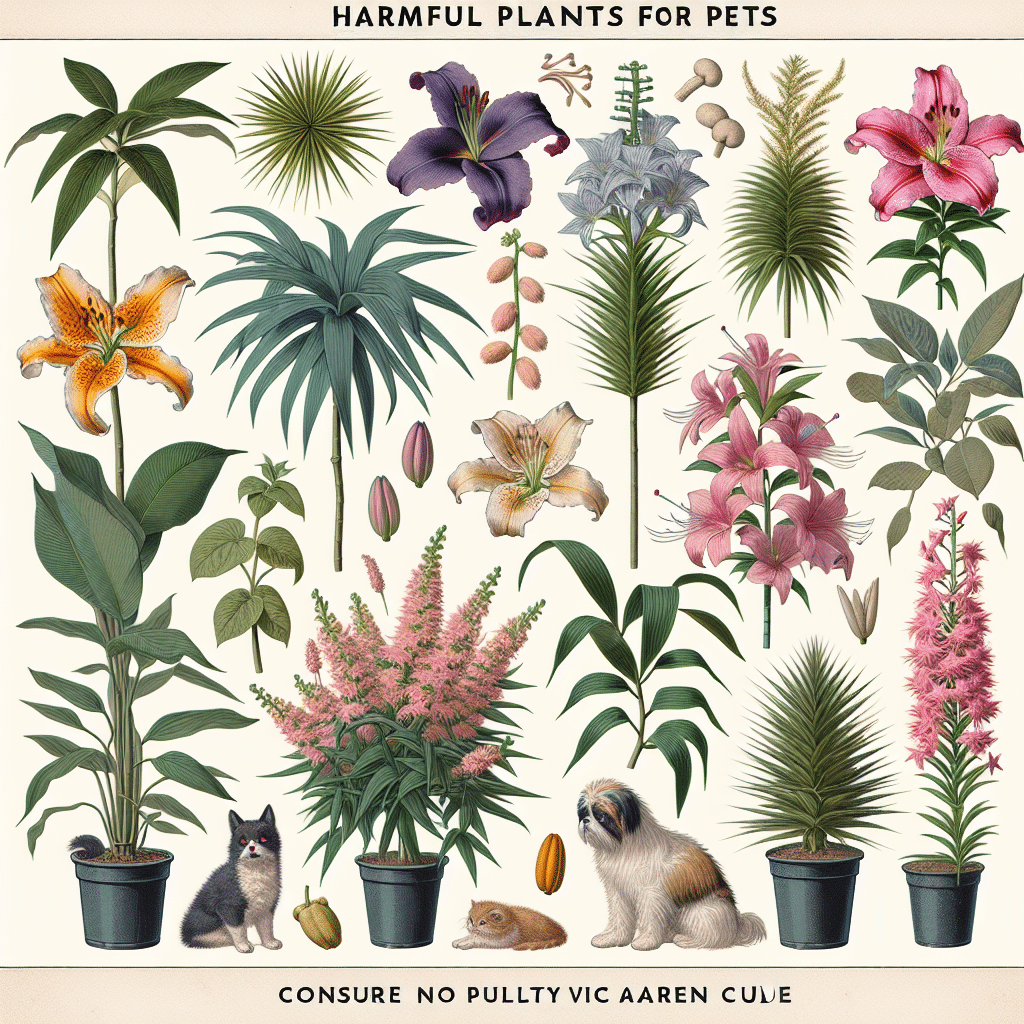Toxic Plant List for Pet Owners
Understanding Plant Toxicity
Pet owners often love to decorate their homes with plants, but it’s crucial to know which ones are safe for your furry friends. Many common household plants can be toxic to cats and dogs. Understanding the risks associated with certain plants can prevent serious health issues for your pets.
Common Toxic Plants for Dogs
-
Sago Palm (Cycas revoluta)
- Toxicity: Very toxic
- Symptoms: Vomiting, diarrhea, seizure, liver failure
- Notes: All parts are toxic, especially the seeds.
-
Oleander (Nerium oleander)
- Toxicity: Extremely toxic
- Symptoms: Drooling, abdominal pain, heart disturbances
- Notes: Even small amounts can be lethal.
-
Azalea (Rhododendron spp.)
- Toxicity: Toxic
- Symptoms: Vomiting, diarrhea, decreased heart rate
- Notes: Consume even a few leaves can cause issues.
-
Castor Bean (Ricinus communis)
- Toxicity: Highly toxic
- Symptoms: Severe abdominal pain, vomiting, diarrhea, dehydration
- Notes: Seeds contain ricin, a potent poison.
-
Foxglove (Digitalis purpurea)
- Toxicity: Very toxic
- Symptoms: Arrhythmias, vomiting, diarrhea
- Notes: Consuming any part can be harmful.
-
Yew (Taxus spp.)
- Toxicity: Extremely toxic
- Symptoms: Breathing difficulties, tremors, cardiac arrest
- Notes: All parts are toxic, except the flesh of the berries.
Common Toxic Plants for Cats
-
Lily (Lilium spp. and Hemerocallis spp.)
- Toxicity: Extremely toxic to cats
- Symptoms: Vomiting, lethargy, kidney failure
- Notes: Even small amounts can cause severe kidney damage.
-
Philodendron (Philodendron spp.)
- Toxicity: Mild to moderate toxicity
- Symptoms: Oral irritation, difficulty swallowing, excessive drooling
- Notes: Often found in homes; consume with caution.
-
Pothos (Epipremnum aureum)
- Toxicity: Mildly toxic
- Symptoms: Oral irritation, vomiting, nausea
- Notes: Popular houseplant; irritation mostly occurs when chewed.
-
Easter Lily (Lilium)
- Toxicity: Extremely toxic to cats
- Symptoms: Vomiting, lethargy, increased thirst, kidney failure
- Notes: Highly dangerous; prefer non-toxic decoration options.
-
Caladium (Caladium spp.)
- Toxicity: Moderate toxicity
- Symptoms: Oral irritation, swelling, reddening of tongue
- Notes: Considered decorative but hazardous.
Common Toxic Plants for Both Cats and Dogs
-
Chrysanthemum (Chrysanthemum spp.)
- Toxicity: Mildly toxic
- Symptoms: Vomiting, diarrhea, lack of appetite
- Notes: Symptoms are generally mild but can cause discomfort.
-
Tulip (Tulipa spp.)
- Toxicity: Moderately toxic
- Symptoms: Vomiting, diarrhea, abdominal pain
- Notes: Bulbs are particularly toxic.
-
Cyclamen (Cyclamen spp.)
- Toxicity: Highly toxic
- Symptoms: Vomiting, diarrhea, increased salivation
- Notes: Consuming the tuber can lead to serious health issues.
-
Kalanchoe (Kalanchoe spp.)
- Toxicity: Moderately toxic
- Symptoms: Vomiting, diarrhea, changes in heart rate
- Notes: Keep away from pets to prevent gastrointestinal problems.
-
Cactus (Cactaceae)
- Toxicity: Mildly toxic
- Symptoms: Skin irritation, vomiting
- Notes: The thorns can also cause physical injury.
Prevention and Safety Measures
- Educate Yourself: Familiarize yourself with plants that are toxic to your pets.
- Create a Pet-Safe Zone: Keep plants out of reach or choose non-toxic alternatives.
- Consult Experts: If unsure about a particular plant, consult your veterinarian or a pet toxicologist.
- Identify Symptoms: Know what symptoms to look for in case your pet ingests a toxic plant.
- Immediate Action: If you suspect your pet has ingested a toxic plant, contact your veterinarian immediately.
Safe Alternatives for Pet Owners
- Spider Plant (Chlorophytum comosum): Safe for both dogs and cats; easy to care for.
- Boston Fern (Nephrolepis exaltata): Non-toxic and air-purifying.
- Areca Palm (Dypsis lutescens): Safe and effective for improving indoor air quality.
- Bamboo Palm (Chamaedorea seifrizii): Toxic-free; great for adding greenery indoors.
- Christmas Cactus (Schlumbergera spp.): Safe and brings festive decor without risk.
By staying informed and cautious, pet owners can enjoy the beauty of indoor plants while ensuring their beloved companions remain safe and healthy.
